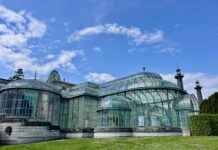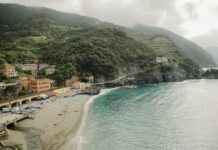«It was beautiful before. We had everyone here: Pierre Tchernia, Michel Drucker, Sim. There was a florist, an aquarist, a horse butcher,» says Olivier Klein, 55, a neighborhood child who became mayor of this city of Seine-Saint-Denis, where the shopping center was built in the 1970s.
But the dreams of a motorway that were to enhance the attractiveness of the densely populated district evaporated in the 1980s, and with them the brilliance of the 4,000 m2 of the shopping mall.
Forty years later and the establishment not far from supermarkets, only a café, grocery stores and a dozen shops still survive under the neon lights and the whitish tiling of the center, partly built under the bars with calamitous facades.
«With the closure of the discount clothing store and the departure of health professionals, we lost 20-25% of our activity», laments pharmacist Christian Moafo.
This shortfall was accentuated, according to the traders interviewed, by the departure of hundreds of people linked to the operation to requalify degraded condominiums. Started in 2015, this titanic program now piloted by the Ile-de-France public land establishment provides for the destruction of around ten buildings and the construction of more than 1,300 housing units.
«I’m living in hell,» says Mr. Moafo. With each storm, the pharmacist says he fears that the leaks will flood his premises. «I dream of seeing the bulldozers destroy the center». They should arrive in 2026.
– Bakery, hairdresser, café –
Until then, milestones are being laid. It is a question of choosing the businesses of the new Chêne-Pointu, linchpins of the metamorphosis supposed to open up the district and reduce the obstacles to social diversity. They will be distributed on the ground floor of new buildings.
Candidates have until the end of May to present a file before a pre-selection by July and the examination of their financial situation, indicates Isabelle Labaye of Immobilière 3F, the lessor in charge of the transfer and support of businesses. With regard to the shops envisaged, «we stay in the basics» with a bakery, a hairdresser, a café. «The goal is to create a shopping area to give life and create links. The stakes are enormous for the inhabitants,» she explains.
But how to combine the «average basket» of the current population with the «upmarket» desired by the town hall?
The Court of Auditors noted in 2019 «a phenomenon of economic and commercial decline» in the priority districts of the city such as that of Clichy-sous-Bois, and this despite ten years of renovation programs, powerless to embellish the image in the long term. of these territories. In these neighborhoods, the poverty rate is 42%, three times higher than elsewhere, and the unemployment rate is 22.5%, according to government data.
– Future Street –
Le Chêne-Pointu therefore intends to initiate a virtuous circle. “To redo the city is to be interested in school, mobility, employment, and access to shops”, summarizes Mr. Klein.
In the rue de l’Avenir, the Post Office will serve as an «attractive locomotive» as will the future conservatory, a nearby Grand Paris station, and, hopes the town hall, medium-sized stores such as Aldi and Lidl with whom discussions are in class.
If the town hall says it does not have the financial means to dredge up businesses, it has one ambition: «to have the ability to be sexier» and to «prevent an ugly kebab from being replaced by an ugly kebab».
This will involve support in the presentation of the windows, the presence of commercial mediators and «guardians very close to the shops», according to I3F.
Not all current traders will be able to match the new rents. The pharmacist in the neighboring neighborhood who has just been rehabilitated confirms that his rent has more than doubled since the renovation.
But for some professionals in Chêne-Pointu, «we are so tired of being here, it’s so toxic that we don’t even think about this problem of rents», says Mr. Moafo. «We just pray that there is no delay» in the work.
















